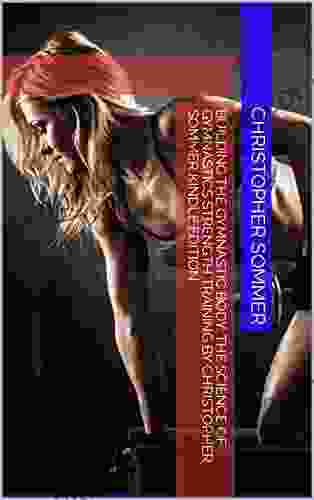Building the Gymnastic Body: A Comprehensive Guide to Achieving Elite Strength, Power, and Flexibility

Gymnasts are renowned for their incredible strength, power, and flexibility. Their bodies are capable of performing astonishing feats of athleticism, from soaring through the air on the uneven bars to executing intricate floor routines. But how do gymnasts achieve such an extraordinary level of physical prowess?
5 out of 5
| Language | : | English |
| File size | : | 21136 KB |
| Text-to-Speech | : | Enabled |
| Screen Reader | : | Supported |
| Enhanced typesetting | : | Enabled |
| Word Wise | : | Enabled |
| Print length | : | 346 pages |
| Lending | : | Enabled |
The answer lies in a combination of rigorous training, proper nutrition, and a deep understanding of the body's biomechanics. In this comprehensive guide, we will explore the key elements of gymnastics training and provide you with actionable tips and exercises to help you build a gymnastic body of your own.
Strength Training for Gymnasts
Strength is the foundation of gymnastics training. Gymnasts require immense strength in their upper body, core, and legs to perform the demanding movements of their sport. Strength training helps gymnasts develop the power and stability necessary to lift their own body weight, control their movements, and absorb衝撃。
There are a variety of strength training exercises that gymnasts can incorporate into their training routines, including:
- Pull-ups
- Chin-ups
- Dips
- Push-ups
- Squats
- Lunges
- Deadlifts
- Planks
- Russian twists
- Leg raises
When performing strength training exercises, gymnasts should focus on compound movements that work multiple muscle groups simultaneously. This helps to maximize efficiency and build overall strength. It is also important to use proper form to avoid injury and ensure that the exercises are targeting the desired muscle groups.
Power Training for Gymnasts
In addition to strength, gymnasts also require explosive power to perform their dynamic movements. Power is the ability to generate force quickly, and it is essential for gymnasts to be able to launch themselves into the air, execute flips, and perform other high-impact maneuvers.
There are a number of power training exercises that gymnasts can use to improve their explosive abilities, including:
- Box jumps
- Squat jumps
- Lunges with jumps
- Clapping push-ups
- Med ball throws
- Sprints
- Plyometrics
When performing power training exercises, gymnasts should focus on exercises that require them to generate force rapidly. It is also important to use proper form to avoid injury and ensure that the exercises are targeting the desired muscle groups.
Flexibility Training for Gymnasts
Flexibility is another essential component of gymnastics training. Gymnasts need to be able to move their bodies through a wide range of motion in order to perform the complex skills of their sport. Flexibility helps gymnasts to avoid injuries, improve their performance, and enhance their overall quality of movement.
There are a variety of flexibility exercises that gymnasts can incorporate into their training routines, including:
- Stretching
- Yoga
- Pilates
- Dance
- Tai chi
When performing flexibility exercises, gymnasts should focus on exercises that target the major muscle groups used in gymnastics. It is also important to stretch slowly and gently, and to hold each stretch for 30 seconds or more.
Nutrition for Gymnasts
Proper nutrition is essential for gymnasts to achieve their full potential. Gymnasts need to consume a nutrient-rich diet that provides them with the energy, protein, and other nutrients they need to support their intense training and recovery.
The following are some of the key nutrients that gymnasts should focus on:
- Carbohydrates: Carbohydrates provide gymnasts with the energy they need to power their workouts and perform at their best.
- Protein: Protein is essential for building and repairing muscle tissue. Gymnasts should aim to consume 1.2-2.0 grams of protein per kilogram of body weight per day.
- Fat: Fat is an important source of energy for gymnasts. Healthy fats, such as those found in avocados, nuts, and seeds, can help gymnasts to feel full and satisfied, and they can also help to reduce inflammation.
- Vitamins and minerals: Vitamins and minerals are essential for overall health and well-being. Gymnasts should aim to consume a variety of fruits, vegetables, and whole grains to ensure that they are getting the vitamins and minerals they need.
In addition to eating a healthy diet, gymnasts should also stay hydrated by drinking plenty of water throughout the day.
Recovery for Gymnasts
Recovery is an essential part of gymnastics training. Gymnasts need to give their bodies time to rest and repair in order to avoid injuries and optimize their performance. Recovery can be achieved through a variety of methods, including:
- Sleep: Sleep is essential for recovery. Gymnasts should aim to get 8-10 hours of sleep per night.
- Nutrition: Eating a healthy diet helps to provide gymnasts with the nutrients they need to recover from their workouts.
- Hydration: Staying hydrated helps to flush out waste products and promote recovery.
- Massage: Massage can help to reduce muscle soreness and promote relaxation.
- Active recovery: Active recovery involves performing light exercise, such as walking or swimming, to help promote blood flow and recovery.
By following these tips, gymnasts can build the strong, powerful, and flexible bodies they need to achieve their goals.
Building the gymnastic body requires a commitment to hard work, dedication, and proper nutrition. By following the principles outlined in this guide, you can develop the strength, power, and flexibility you need to perform like a gymnast.
5 out of 5
| Language | : | English |
| File size | : | 21136 KB |
| Text-to-Speech | : | Enabled |
| Screen Reader | : | Supported |
| Enhanced typesetting | : | Enabled |
| Word Wise | : | Enabled |
| Print length | : | 346 pages |
| Lending | : | Enabled |
Do you want to contribute by writing guest posts on this blog?
Please contact us and send us a resume of previous articles that you have written.
 Fiction
Fiction Non Fiction
Non Fiction Romance
Romance Mystery
Mystery Thriller
Thriller SciFi
SciFi Fantasy
Fantasy Horror
Horror Biography
Biography Selfhelp
Selfhelp Business
Business History
History Classics
Classics Poetry
Poetry Childrens
Childrens Young Adult
Young Adult Educational
Educational Cooking
Cooking Travel
Travel Lifestyle
Lifestyle Spirituality
Spirituality Health
Health Fitness
Fitness Technology
Technology Science
Science Arts
Arts Crafts
Crafts DIY
DIY Gardening
Gardening Petcare
Petcare Gaurav Suri
Gaurav Suri Necoco
Necoco Christopher Sommer
Christopher Sommer Daniel P Murphy
Daniel P Murphy Jefferson Hawkins
Jefferson Hawkins 18th Edition Kindle Edition
18th Edition Kindle Edition Janet Wolanin Alexander
Janet Wolanin Alexander Deaver Brown
Deaver Brown Linda Eyre
Linda Eyre Will Thornton
Will Thornton Marta Obiols Llistar
Marta Obiols Llistar Andrea Komlosy
Andrea Komlosy Sudhir Shirwadkar
Sudhir Shirwadkar Candace Clark Trinchieri
Candace Clark Trinchieri Steven Johnson
Steven Johnson Bruce Bowlen
Bruce Bowlen Robin Mamlet
Robin Mamlet Andrew Doughty
Andrew Doughty Florent Buisson
Florent Buisson Donna Bollinger
Donna Bollinger Usa Pickleball Association
Usa Pickleball Association Andrea Bemis
Andrea Bemis Rachel Meltzer Warren
Rachel Meltzer Warren Lucia Ashta
Lucia Ashta Dana Mccullough
Dana Mccullough Pete Pfitzinger
Pete Pfitzinger Namina Forna
Namina Forna Nikola Tesla
Nikola Tesla Jeremy Freese
Jeremy Freese Leisy J Abrego
Leisy J Abrego Jason Welker
Jason Welker Course Hero
Course Hero Steve Sheinkin
Steve Sheinkin Aldous Huxley
Aldous Huxley Clayton Everline
Clayton Everline Thomas Meyer
Thomas Meyer Zak Mt Standridge
Zak Mt Standridge Lena Shev
Lena Shev Leslie Vedder
Leslie Vedder Benedict Carey
Benedict Carey Andre Watson
Andre Watson Vertamae Smart Grosvenor
Vertamae Smart Grosvenor Richard P Feynman
Richard P Feynman Tracy Townsend
Tracy Townsend Daniel Humm
Daniel Humm Andrew Goliszek
Andrew Goliszek Jessica Mccrory Calarco
Jessica Mccrory Calarco Tony Herman
Tony Herman Matt Fulks
Matt Fulks Roberto Pedreira
Roberto Pedreira David Abram
David Abram Brenda Reed Pilcher
Brenda Reed Pilcher Ian Tattersall
Ian Tattersall Christine Balaz
Christine Balaz M D Johnson
M D Johnson Prasad Raju V V N R Pathapati
Prasad Raju V V N R Pathapati Richard Bolstad
Richard Bolstad Sara Manning Peskin
Sara Manning Peskin Samantha Rodman
Samantha Rodman Seth Reichelson
Seth Reichelson Antonio Iturbe
Antonio Iturbe Marcus A Pfeiffer
Marcus A Pfeiffer Terry Ann Williams Richard
Terry Ann Williams Richard Sarah Outen
Sarah Outen Richard Bellman
Richard Bellman C B Lee
C B Lee Loren Pope
Loren Pope Tom Lecompte
Tom Lecompte Gerald A Moore Sr
Gerald A Moore Sr Ewen Levick
Ewen Levick David Alloway
David Alloway Donald S Murray
Donald S Murray Thomas Berger
Thomas Berger Melissa Caughey
Melissa Caughey Jack Purdum
Jack Purdum Wildlife Trusts
Wildlife Trusts V E Schwab
V E Schwab Ken Blanchard
Ken Blanchard Rolf Potts
Rolf Potts Richard N Aufmann
Richard N Aufmann Ben Orlin
Ben Orlin Malinda Lo
Malinda Lo Catherine Montgomery
Catherine Montgomery Greg Presto
Greg Presto Kristen Thone
Kristen Thone Kathleen Dean Moore
Kathleen Dean Moore Sandy Stott
Sandy Stott Sarah Castille
Sarah Castille Kenneth S Shultz
Kenneth S Shultz Mara Vorhees
Mara Vorhees Joe Posnanski
Joe Posnanski Patrick Hatt
Patrick Hatt Robert Jay Lifton
Robert Jay Lifton Elizabeth S Meckes
Elizabeth S Meckes Simon Garfield
Simon Garfield David Borgenicht
David Borgenicht Giada De Laurentiis
Giada De Laurentiis Jon Gillespie Brown
Jon Gillespie Brown 24th Edition Kindle Edition
24th Edition Kindle Edition Christine Heppermann
Christine Heppermann Patrick Mouratoglou
Patrick Mouratoglou Hayley Campbell
Hayley Campbell Robert B Yonaitis
Robert B Yonaitis Mike Davenport
Mike Davenport Michael Hermann
Michael Hermann Bernard Craw
Bernard Craw Brad Schoenfeld
Brad Schoenfeld Andrea Cremer
Andrea Cremer Sue Fierston
Sue Fierston Nic Oatridge
Nic Oatridge Gary Thomas
Gary Thomas Elizabeth S Trafalgar
Elizabeth S Trafalgar John Bantin
John Bantin Tom Siegfried
Tom Siegfried Ben Doughty
Ben Doughty Kathryne Kennedy
Kathryne Kennedy Julie Miller
Julie Miller James Geary
James Geary Serena Valentino
Serena Valentino Joseph Ledoux
Joseph Ledoux Brian Azzarello
Brian Azzarello Keith Sutton
Keith Sutton Victoria Schwab
Victoria Schwab Paul Abell
Paul Abell Raymond Coppinger
Raymond Coppinger Michele Leathers
Michele Leathers Laura Lincoln Maitland
Laura Lincoln Maitland William Gerin
William Gerin Nick Peters
Nick Peters A J Carlisle
A J Carlisle James Fox
James Fox Steven Arms
Steven Arms Robin Satty
Robin Satty Jim Apfelbaum
Jim Apfelbaum Ian O Connor
Ian O Connor Elizabeth Clor
Elizabeth Clor Mara Rockliff
Mara Rockliff Rachael Chapman
Rachael Chapman Paco Underhill
Paco Underhill Sheila Jasanoff
Sheila Jasanoff Stacey Little
Stacey Little Bettina Bonifatti
Bettina Bonifatti Steven Poses
Steven Poses Steve Bisheff
Steve Bisheff Andrew Duncan
Andrew Duncan Guillermo Ferrara
Guillermo Ferrara Garcilaso De La Vega
Garcilaso De La Vega Ola Ola
Ola Ola Hampton Sides
Hampton Sides Kirby Arnold
Kirby Arnold Erich Neumann
Erich Neumann Ralph Zuranski
Ralph Zuranski S Fatou
S Fatou Matt Richtel
Matt Richtel Jaak Panksepp
Jaak Panksepp Bhavesh Mamtani
Bhavesh Mamtani Nancy B Rapoport
Nancy B Rapoport Kailin Gow
Kailin Gow Maria Konnikova
Maria Konnikova Lynne L Finch
Lynne L Finch Rachel Hawkins
Rachel Hawkins Sean Pidgeon
Sean Pidgeon Susan Williams White
Susan Williams White Ken Gullette
Ken Gullette Ed Willes
Ed Willes Terence Callery
Terence Callery Greg Ruth
Greg Ruth Jordan Romero
Jordan Romero Charlotte Elkins
Charlotte Elkins Paulette F C Steeves
Paulette F C Steeves Ronald D Davis
Ronald D Davis Luke Rosiak
Luke Rosiak Joe Cavallaro
Joe Cavallaro Kevin Cook
Kevin Cook Robert Hamill
Robert Hamill Arlo Adams
Arlo Adams Jay Greeson
Jay Greeson Tim Wharnsby
Tim Wharnsby Isabel Sterling
Isabel Sterling Gabby Rivera
Gabby Rivera Martin Rooney
Martin Rooney Rich Luhr
Rich Luhr Kelly Tyler Lewis
Kelly Tyler Lewis Kyle Keegan
Kyle Keegan C L Werner
C L Werner Cliff Wilson
Cliff Wilson Mark M Meerschaert
Mark M Meerschaert Anne Bogel
Anne Bogel Thomas S Kuhn
Thomas S Kuhn Lilith Starr
Lilith Starr Brian C Muraresku
Brian C Muraresku Kindra Gordon
Kindra Gordon Joseph Luzzi
Joseph Luzzi Ivan Pastine
Ivan Pastine Kiersten White
Kiersten White Jennifer L Armentrout
Jennifer L Armentrout Jennifer Blair
Jennifer Blair Barbara Merry
Barbara Merry Ann Gadzikowski
Ann Gadzikowski Craig Custance
Craig Custance Peter May
Peter May Jenny Mackay
Jenny Mackay Luke Hohmann
Luke Hohmann Sorin Dumitrascu
Sorin Dumitrascu Walter Greiner
Walter Greiner Andrew Blauner
Andrew Blauner Stephan J Guyenet
Stephan J Guyenet Andrea Curtis
Andrea Curtis Paul Rooyackers
Paul Rooyackers Andrew Feinberg
Andrew Feinberg John Ramirez
John Ramirez Peter Boardman
Peter Boardman Caren Van Slyke
Caren Van Slyke Galit Shmueli
Galit Shmueli Karen Robson
Karen Robson Department Of Defense
Department Of Defense H Spencer Lewis
H Spencer Lewis George Mahood
George Mahood Leslie Sokol
Leslie Sokol Jack Hunnicutt
Jack Hunnicutt Joseph Terry
Joseph Terry Tom Lodziak
Tom Lodziak Ryan Pellett
Ryan Pellett James Mallory
James Mallory Pietro Matracchi
Pietro Matracchi Gabrielle Coleman
Gabrielle Coleman Gemma Rogers
Gemma Rogers Robyn Sheldon
Robyn Sheldon D Harvey
D Harvey Chris Salisbury
Chris Salisbury Luigi Gabriele Conti
Luigi Gabriele Conti Rob Summers
Rob Summers Sameera Khan Rd Pa C
Sameera Khan Rd Pa C Katharine B Soper
Katharine B Soper James Lyons Weiler
James Lyons Weiler Carrie Ryan
Carrie Ryan Timothy Johnson
Timothy Johnson Joey Miller Msw Lcsw
Joey Miller Msw Lcsw Kerri Andrews
Kerri Andrews Bruce D Perry
Bruce D Perry Patrick W Galbraith
Patrick W Galbraith Andrew Greiner
Andrew Greiner Peter David
Peter David Mark Hume
Mark Hume Romney Steele
Romney Steele Wolfgang Hohlbein
Wolfgang Hohlbein Chris Lilly
Chris Lilly Jim Curran
Jim Curran Mike Gauthier
Mike Gauthier Steven J Matthiesen
Steven J Matthiesen Robert Sky Allen Ph D
Robert Sky Allen Ph D W J Hendry
W J Hendry Frans De Waal
Frans De Waal Suzy Ashworth
Suzy Ashworth Jeff Davis
Jeff Davis Francesca Zappia
Francesca Zappia Jonathan Cummings
Jonathan Cummings Rick Westhead
Rick Westhead Wendy Heard
Wendy Heard Bruce Mcnall
Bruce Mcnall Dr Gabriel Peter Salgo
Dr Gabriel Peter Salgo Lundy Bancroft
Lundy Bancroft Jennifer Anne Davis
Jennifer Anne Davis Lonely Planet
Lonely Planet Laura Domino
Laura Domino Anne Marie Meyer
Anne Marie Meyer Shaun Assael
Shaun Assael Denise Riebe
Denise Riebe Laurie Seale
Laurie Seale Hasok Chang
Hasok Chang Melissa Reynolds
Melissa Reynolds Joe Wells
Joe Wells Rashers Tierney
Rashers Tierney Karen Tranberg Hansen
Karen Tranberg Hansen Dorothy Pang
Dorothy Pang Steven M Fiser
Steven M Fiser Peter Mcbride
Peter Mcbride Rizwan Virk
Rizwan Virk Christina Kim
Christina Kim Anne Holler
Anne Holler Bisco Hatori
Bisco Hatori Anna Holmwood
Anna Holmwood Dot Edu
Dot Edu Minal Hajratwala
Minal Hajratwala Rick Heard
Rick Heard Bridget Portmann
Bridget Portmann Robert Bacal
Robert Bacal George Christian Pappas
George Christian Pappas Julie Powers
Julie Powers Elizabeth Marshall Thomas
Elizabeth Marshall Thomas James E Wisher
James E Wisher Gwendolyn Griffith Lieuallen
Gwendolyn Griffith Lieuallen Michael Anderle
Michael Anderle Meiso
Meiso David Scott
David Scott Andrea Olson
Andrea Olson Mason Deaver
Mason Deaver Brandon Mull
Brandon Mull Steve Caplin
Steve Caplin Bonita Norris
Bonita Norris Jimmy Elliott
Jimmy Elliott Christian Keur
Christian Keur Susanna Kearsley
Susanna Kearsley Connie J Wells
Connie J Wells Joseph Bruchac
Joseph Bruchac Jason Louv
Jason Louv William F Sensakovic
William F Sensakovic Annette Curtis Klause
Annette Curtis Klause Andrea Gonzales
Andrea Gonzales Andrea Cataldo
Andrea Cataldo Big Daddy Ozone
Big Daddy Ozone Peter Scazzero
Peter Scazzero Jason Zemcik
Jason Zemcik Noel Janis Norton
Noel Janis Norton Laurie Ann Thompson
Laurie Ann Thompson Chiara Marletto
Chiara Marletto Stephanie Cacioppo
Stephanie Cacioppo Robert H Miller
Robert H Miller Richard Heinberg
Richard Heinberg Catie Czora
Catie Czora Steve Scott
Steve Scott Stephen Wiggins
Stephen Wiggins Hugh Raffles
Hugh Raffles James Dodson
James Dodson Michael Judge
Michael Judge James Turnbull
James Turnbull Mira Kirshenbaum
Mira Kirshenbaum Chris Mcmullen
Chris Mcmullen Dayton O Hyde
Dayton O Hyde Andrea Flores
Andrea Flores Jakub Marian
Jakub Marian Becky Lomax
Becky Lomax Linda Anne Silvestri
Linda Anne Silvestri Jamie Ivey
Jamie Ivey Lori Shandle Fox
Lori Shandle Fox Andrew St Pierre White
Andrew St Pierre White Tod Schimelpfenig
Tod Schimelpfenig Steve Anthony Tallon
Steve Anthony Tallon Marvin L Bittinger
Marvin L Bittinger Lars Muhl
Lars Muhl Pliny The Elder
Pliny The Elder Ruby Walker
Ruby Walker Laird Hamilton
Laird Hamilton John Gilbert
John Gilbert Jenna Miscavige Hill
Jenna Miscavige Hill Bill O Neill
Bill O Neill Morihei Ueshiba
Morihei Ueshiba James A Middleton
James A Middleton Paul Stamets
Paul Stamets Roger Atwood
Roger Atwood Arianna Astuni
Arianna Astuni C L Mississippi Morgan
C L Mississippi Morgan Harriet Brown
Harriet Brown Arous Brocken
Arous Brocken Andrej Spec
Andrej Spec Adam Mansbach
Adam Mansbach Richard Maury
Richard Maury Nick Marshall
Nick Marshall Bobby Orr
Bobby Orr Lisa Bond
Lisa Bond Jonathan Clements
Jonathan Clements Ricky Moore
Ricky Moore Dylan Norton
Dylan Norton Marcus Felson
Marcus Felson Charles H Hapgood
Charles H Hapgood Robin Ha
Robin Ha April Vahle Hamel
April Vahle Hamel John Morton
John Morton E K Johnston
E K Johnston Jen Calonita
Jen Calonita Future Publishing
Future Publishing Robin Hobb
Robin Hobb Riley Black
Riley Black Brock Eide
Brock Eide Marissa Meyer
Marissa Meyer Patsy M Lightbown
Patsy M Lightbown Stephen Chbosky
Stephen Chbosky Kjartan Poskitt
Kjartan Poskitt Tamara Ireland Stone
Tamara Ireland Stone Rashid Khalidi
Rashid Khalidi Kristin Briney
Kristin Briney Stan Tekiela
Stan Tekiela Andrea Hudy
Andrea Hudy Joelle Charbonneau
Joelle Charbonneau Jenn Brandt
Jenn Brandt George E P Box
George E P Box Roland Martin
Roland Martin Vin T Sparano
Vin T Sparano Kelsie Stelting
Kelsie Stelting Andy Bull
Andy Bull Ronald J Harshbarger
Ronald J Harshbarger Claire Maxted
Claire Maxted Rita Jablonski
Rita Jablonski Neil Oliver
Neil Oliver Tim Ryan
Tim Ryan Kristine Papin Morris
Kristine Papin Morris Mandy Baggot
Mandy Baggot Bernard A Chavis
Bernard A Chavis Sid Thatte
Sid Thatte Daniel Shiffman
Daniel Shiffman Eugene Raikhel
Eugene Raikhel Mary Jane Sterling
Mary Jane Sterling Buster Benson
Buster Benson Rachel Atwood
Rachel Atwood Marta Szabo
Marta Szabo Oliver Perkins
Oliver Perkins Lauren Daniels
Lauren Daniels Jay Annelli
Jay Annelli J E Lendon
J E Lendon Ronald W Doerfler
Ronald W Doerfler Thomas Watson
Thomas Watson Frances Evesham
Frances Evesham Paul Kalas
Paul Kalas Mark Mcconville
Mark Mcconville Victoria Allman
Victoria Allman David W Brown
David W Brown Jim Shea
Jim Shea Charles Szypszak
Charles Szypszak Whitney Nelson
Whitney Nelson Nancy Mcwilliams
Nancy Mcwilliams James R Morrow Jr
James R Morrow Jr David Montgomery
David Montgomery Mary Keith Piasecki
Mary Keith Piasecki Richard Munson
Richard Munson Andrew Gelman
Andrew Gelman Michael T Nygard
Michael T Nygard Bernard Moitessier
Bernard Moitessier Galen Wolf
Galen Wolf Margaret Thorsborne
Margaret Thorsborne Eric Engle
Eric Engle Michael S Malone
Michael S Malone Raymond E Feist
Raymond E Feist Christos Lynteris
Christos Lynteris Erica Hoke
Erica Hoke Shane Ryan
Shane Ryan Nathaniel Philbrick
Nathaniel Philbrick Andrea Wachter
Andrea Wachter Michio Kaku
Michio Kaku Josh Tabor
Josh Tabor Sandra Glosser
Sandra Glosser James Willstrop
James Willstrop Gregory Curtis
Gregory Curtis Doug Swisher
Doug Swisher Geoffrey Wolff
Geoffrey Wolff Gillian Tett
Gillian Tett Jed Z Buchwald
Jed Z Buchwald Cathal Armstrong
Cathal Armstrong Dani Jacobs
Dani Jacobs Carmen Micsa
Carmen Micsa Mike Cyra
Mike Cyra Andrew Brown
Andrew Brown George Hospodar
George Hospodar Andrew Beyer
Andrew Beyer James Rebanks
James Rebanks Leigh Bardugo
Leigh Bardugo Sunny Anderson
Sunny Anderson William Ritter
William Ritter Victoria Ortiz
Victoria Ortiz Jacqueline Edmondson
Jacqueline Edmondson Rajani Katta
Rajani Katta Tillie Walden
Tillie Walden Leslie Morgan Steiner
Leslie Morgan Steiner Baz Thompson
Baz Thompson Milo Stewart
Milo Stewart L Michele Issel
L Michele Issel Pat Wray
Pat Wray Steven H Weintraub
Steven H Weintraub Bob Mayer
Bob Mayer Rob Taylor
Rob Taylor J David Logan
J David Logan Stuart L Kaplan M D
Stuart L Kaplan M D Nancy Mather
Nancy Mather Trish Allison
Trish Allison Kelly Oliver
Kelly Oliver Kylie Lee Baker
Kylie Lee Baker James Branch Cabell
James Branch Cabell Emily Henry
Emily Henry Metin Bektas
Metin Bektas Rupert Sheldrake
Rupert Sheldrake
Light bulbAdvertise smarter! Our strategic ad space ensures maximum exposure. Reserve your spot today!

 Michael ChabonThe Devils of Loudun: Aldous Huxley's Masterful Exploration of Mass Hysteria...
Michael ChabonThe Devils of Loudun: Aldous Huxley's Masterful Exploration of Mass Hysteria...
 Harrison BlairHow to Analyze Data Like a Pro: A Comprehensive Guide for Pocket Study Skills
Harrison BlairHow to Analyze Data Like a Pro: A Comprehensive Guide for Pocket Study Skills
 Clarence MitchellUnveiling the Resonant Themes and Literary Devices in Gabby Rivera's The Cape...
Clarence MitchellUnveiling the Resonant Themes and Literary Devices in Gabby Rivera's The Cape... Milan KunderaFollow ·17.8k
Milan KunderaFollow ·17.8k James HayesFollow ·2.6k
James HayesFollow ·2.6k Robert Louis StevensonFollow ·18.1k
Robert Louis StevensonFollow ·18.1k Jan MitchellFollow ·8.5k
Jan MitchellFollow ·8.5k Carlos FuentesFollow ·4.1k
Carlos FuentesFollow ·4.1k Cody BlairFollow ·2.9k
Cody BlairFollow ·2.9k Vladimir NabokovFollow ·8.2k
Vladimir NabokovFollow ·8.2k Forrest BlairFollow ·9.2k
Forrest BlairFollow ·9.2k

 Demetrius Carter
Demetrius CarterGolf Scrimmages: Realistic Practice Games Under Pressure
Golf scrimmages are...

 Andres Carter
Andres CarterAhsoka Tano: The Force-Wielding Togruta Who Shaped the...
Ahsoka Tano is one of the most...

 Greg Foster
Greg FosterUndeath Ascendant: A Blood-Soaked Literary Odyssey into...
Immerse yourself in a macabre tapestry of...

 Paulo Coelho
Paulo CoelhoHow an English Polymath and French Polyglot Discovered...
The Rosetta Stone is...
5 out of 5
| Language | : | English |
| File size | : | 21136 KB |
| Text-to-Speech | : | Enabled |
| Screen Reader | : | Supported |
| Enhanced typesetting | : | Enabled |
| Word Wise | : | Enabled |
| Print length | : | 346 pages |
| Lending | : | Enabled |










